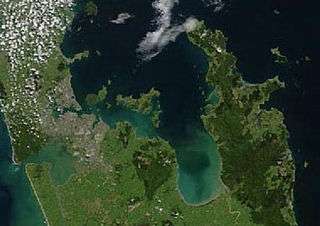Franklin District
| Franklin | |
|---|---|
| Former territorial authority | |
|
| |
| Coordinates: 37°14′S 175°00′E / 37.24°S 175.00°ECoordinates: 37°14′S 175°00′E / 37.24°S 175.00°E | |
| Country | New Zealand |
| Area | |
| • Total | 2,187.94 km2 (844.77 sq mi) |
| Extent |
Papakura to Meremere; Port Waikato to Miranda, Firth of Thames |
Franklin District is a former New Zealand territorial authority that lay between the Auckland metropolitan area and the Waikato Plains. As a formal territory it was abolished on 31 October 2010 and divided between Auckland Council in the Auckland Region (39.82 percent by land area) to the north and Waikato and Hauraki districts in the Waikato Region (60.18 percent) to the south and east. The Auckland portion is now part of the Franklin ward, which also includes rural parts of the former Manukau City.
Before its abolition, it was administered from the town of Pukekohe. Out-going Franklin District Mayor Mark Ball had proposed that Franklin district become an independent unitary authority, fulfilling both the functions of a local and regional council. However, this was rejected by Minister Rodney Hide.[1]
Location and extent
The district was bounded in the north by the start of the Auckland metropolitan area and the waters of the Manukau Harbour. Awhitu Peninsula stretches up the Tasman coast to the mouth of this harbour. Here are located several holiday spots, such as Kariotahi Beach and Matakawau.
To the south, Franklin was bounded by the fertile lowlands of the Waikato Plains. In the east, the land rises to the Hunua Ranges, then falls to the coast of the Firth of Thames. In the west is the Tasman Sea. The Waikato River mouth is at Port Waikato in the south of the region. This is renowned as a good place for surfcasting.
The area is mainly rural, with local settlements such as Waiuku and Tuakau supporting the farming industry. One industry of note is the New Zealand Steel steel mill at Glenbrook, north of Waiuku.
Nomenclature
The name of "Franklin" probably derives from Lady Jane Franklin, an early British traveller and the wife of Captain Sir John Franklin,[2] who served as Lieutenant-Governor of Van Diemen's Land (1837–1843). Lady Franklin visited the Waikato Heads in 1841.[3]
Media
Franklin County News, a twice-weekly newspaper based in Pukekohe, serves the former Franklin district. The Post Newspaper issues almost 22,000 copies weekly on a Tuesday within Franklin and Tuakau and is based in Waiuku.[4]In 2015 the online directory, events calendar and photo news Franklin Life was launched.
References
- ↑ "Franklin residents split between district councils". The New Zealand Herald. 19 January 2010. Retrieved 30 September 2011.
- ↑ Reed, A. W. (2002). Dowling, Peter, ed. The Reed dictionary of New Zealand place names. Auckland: Reed Books. p. 152. ISBN 0-790-00761-4.
There seems little doubt that the district was named after Lady Jane Franklin, the wife of Sir John Franklin [...], for at a very early date she crossed the Manukau Harbour in a mission schooner and was conveyed by a Maori party to Waiuku, long before there were any settlers in the area. After the Constitution Act of 1853 the area from Newmarket to Lake Taupo was known as the Southern Electorate. In 1860 the electorate was divided, that portion to the east of the Great South Road and the Waikato River being named Franklin, and that on the west Raglan.
- ↑ Ringer, Bruce (2009). "A brief history of local government in the Franklin area". Auckland Libraries. Auckland Council. Retrieved 28 June 2015.
Franklin County took its name after the existing Parliamentary electorate of Franklin. This had evidently been named in honour of Lady Jane Franklin, the wife of Sir John Franklin, the Arctic explorer. Lady Franklin had visited Robert Maunsell's mission station at the Waikato Heads in 1841.
- ↑ "The Post Newspaper". The Post. Retrieved 19 March 2016.
